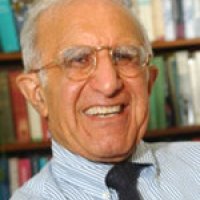Iran's Tumultuous Revolution: 35 Years Later
Four experts discussed the causes and consequences of Iran’s revolution 35 years ago, including the challenges that the world and Iran face today as a result of the 1979 revolution.
On February 10, 2014 the Middle East Program of the Woodrow Wilson Center and the Carnegie Endowment for International Peace hosted an event “Iran's Tumultuous Revolution: 35 Years Later” with Shaul Bakhash, Clarence J. Robinson Professor of History, George Mason University; Mehdi Khalaji, Senior Fellow, Washington Institute for Near East Policy; John Limbert, Distinguished Professor of International Affairs, United States Naval Academy; and Karim Sadjadpour, Senior Associate, Middle East Program, Carnegie Endowment for International Peace. Haleh Esfandiari, Director of the Middle East Program at the Wilson Center, moderated the event.
Bakhash started his talk by discussing the key differences between the 1979 Iran Revolution and the 2011 Egyptian revolution. He maintained that Iran’s revolution had the time to mature over the course of one year, which led to a full-blown revolution. He noted that this lengthy period opened door for wide mobilization, allowing the men around Ayatollah Khomeini to sharpen their message and expand their network, creating the “embryo of a parallel state.” In Egypt, the army sided with the protesters while in Iran the officer corps remained loyal to the Shah until the very end. Bakhash explained that the loyalty of the officer corps to the Shah created the perception that the army was responsible for attempts to put down the revolution. Consequently, with the collapse of the monarchy, the army was denuded of its officer core to avoid any chances of a counter-coup. Bakhash emphasized the critical role of Ayatollah Khomeini in making the revolution possible and the extensive purges of the former ruling elites that allowed a new ruling group to consolidate its position. He noted, however, that the new ruling elite that coalesced around Khomeini first turned against and eliminated rival claimants to power among the wide range of groups that had come together to make the revolution, then began a fierce competition among themselves to determine the future course of the Islamic Republic. These intra-elite rivalries between various stripes of conservatives, pragmatists, and reformers have marked politics in the Islamic Republic over the last two decades and still continue today. The election of Hassan Rouhani as president and his agenda for cautious reform represents the most recent attempt to address the issues engendered by the revolution.
Limbert began by showing pictures of the U.S. embassy hostage crisis (November 4, 1979 - January 20, 1981), referring to that incident as the “second revolution.” He mentioned Ambassador Bruce Laingen’s (the U.S. chargé d'affaires at the time of the hostage crisis) assessment of the situation in Iran in which Laingen put forth two scenarios: 1) continuing the difficult work of rebuilding relations with the new leaders in Iran with unpredictable results or 2) admitting the Shah of Iran to the United States with predictable results, stressing that taking both actions was not possible. Limbert added that Laingen had anticipated that Mehdi Bazargan’s provisional government of nationals and religious intellectuals would be overthrown, orderly U.S.-Iran relations would be interrupted, and the U.S. embassy in Tehran would be under threat if the Shah was admitted to the United States. Limbert then explained that as it later became clear, the real motive behind the hostage crisis was about neither the United States nor the Shah; rather the chief purpose was to bring down the Bazargan government, which was not revolutionary enough and wanted to restore orderly relations with the United States. Limbert pointed to the irony that some of the hostage takers, who had disregarded the rule of law and civil society in 1979, became officials for reformist candidates, such as Habibollah Bitaraf (minister of energy under President Khatami) and Masoumeh Ebtekar (vice president under President Khatami). He concluded by saying that after 34 years both sides have now realized that diplomacy can achieve more and be more satisfactory than always being right.
Sadjadpour discussed the rise and fall of the reform movement, mentioning that the reform movement has been rehabilitated as the result of Hassan Rouhani’s election and the outcome of the Arab Spring. He framed his talk by looking at who the reformists are and what shapes their goals and strategies. Sadjadpour described the reformists as former revolutionaries, who became disillusioned with the revolution, and later tried to make the system more democratic. He emphasized that reformists come from religious backgrounds and are not liberal in Western terms. Sadjadpour believes that former President Mohammad Khatami remains the de facto leader of the reform movement and is the most popular leader in Iran today. Sadjadpour explained that reformists remain faithful to the principles of the revolution but believe in reform and modernization as means to preserve the system. They advocate reintegration of Iran in the outside world. However, he noted that the 2009 uprising revealed that the reformists do not have a precise list of goals. Sadjadpour said through the election of Rouhani, the reform movement is rehabilitated. However, their strategy remains to introduce gradual change.
Khalaji discussed the definition of the term “conservative” in Iran, noting that this group prefers to be called “principalists” or the “right wing” and that he prefers to call them “revolutionaries.” He said that in the first decade after the revolution, the revolutionaries were the leftists; they were close to Ayatollah Khomeini and had the upper hand against the right wing. Khalaji then explained the concept of the guardianship of the jurist as the supreme leader of a state that not only implements Islamic law, but one that is run by a high ranking ayatollah. According to Khalaji, what matters is not necessarily what the shari’a says, but what the Ayatollah says. He then highlighted the fact that during the first decade of the Islamic Republic, Ayatollah Khamenei was not conceived as a revolutionary and that he was not too close to Ayatollah Khomeini. He noted that Ayatollah Khamenei was indeed among the few who opposed Ayatollah Khomeini’s fatwa against Salman Rushdie and he criticized the guardianship of the jurist in Friday Prayers’ sermons. As to relations with the United States, Khalaji maintained that Ayatollah Khamenei believes if he loses his anti-American stance, he will lose his stature within the Islamic world; and will no longer be perceived as a revolutionary.
By the Middle East Program
Speakers


Hosted By

Middle East Program
The Wilson Center’s Middle East Program serves as a crucial resource for the policymaking community and beyond, providing analyses and research that helps inform US foreign policymaking, stimulates public debate, and expands knowledge about issues in the wider Middle East and North Africa (MENA) region. Read more
